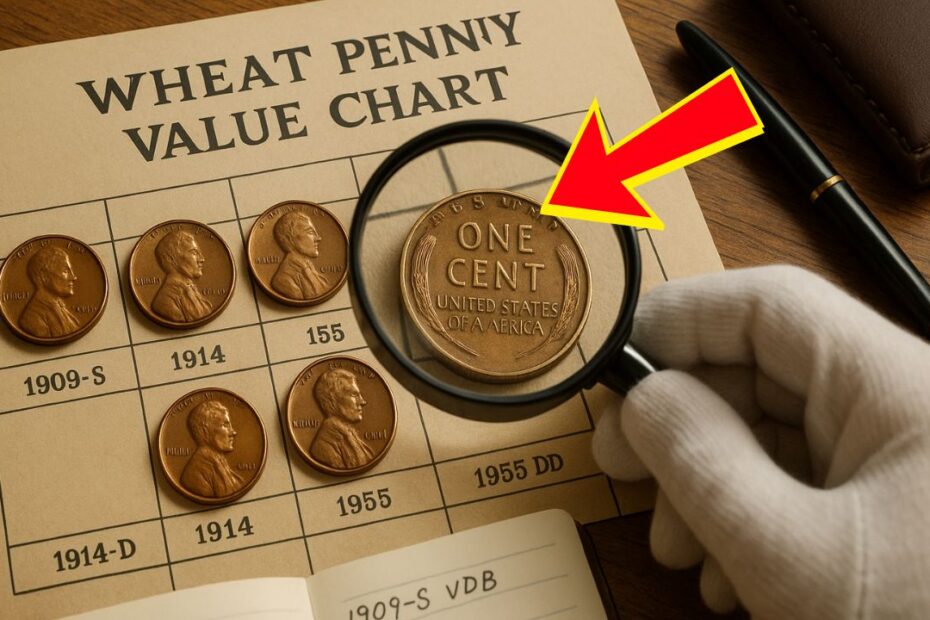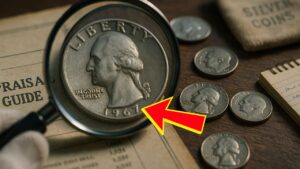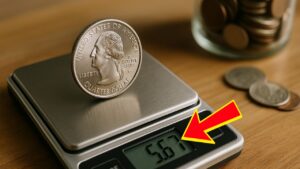The Wheat Penny, officially known as the Lincoln Wheat Cent, is one of the most beloved and collected coins in the United States. Minted from 1909 to 1958, these coins feature the iconic profile of President Abraham Lincoln on the obverse and two stalks of wheat on the reverse.
For collectors and coin enthusiasts, knowing the value of wheat pennies is essential, as certain years, mint marks, and conditions can significantly increase a coin’s worth.
In this guide, we’ll provide a complete wheat penny value chart, explain the key factors that determine the value of your coin, and help you understand which wheat pennies could fetch thousands in the current market.
What Are Wheat Pennies?
The Wheat Penny was introduced in 1909 to commemorate the 100th anniversary of Abraham Lincoln’s birth. Designed by Victor David Brenner, the coin replaced the Indian Head cent and quickly became a staple in American coinage.
Key features include:
- Obverse: Portrait of Abraham Lincoln, “IN GOD WE TRUST,” “LIBERTY,” and the mint year.
- Reverse: Two stalks of wheat on either side, with “ONE CENT” and “UNITED STATES OF AMERICA.”
Wheat pennies are no longer in circulation but remain highly collectible due to their historical significance, rarity, and potential value.
Factors That Affect Wheat Penny Value
Several elements influence the value of a wheat penny:
- Year and Mint Mark – Some years produced fewer coins, making them rarer. Coins from the 1909-S VDB series are among the most valuable.
- Condition/Grade – Coins are graded from Poor (P-1) to Mint State (MS-70). Higher-grade coins are much more valuable.
- Errors and Varieties – Coins with misprints, doubled dies, or unique characteristics can significantly increase in value.
- Copper Content – All wheat pennies before 1982 are primarily copper, which adds a small intrinsic metal value.
Complete Wheat Penny Value Chart (1909–1958)
Below is a comprehensive table showing approximate values for wheat pennies in average circulated condition. Prices can increase dramatically for higher-grade coins or rare varieties.
| Year | Mint Mark | Average Circulated Value | Key Notes |
|---|---|---|---|
| 1909 | No S, No VDB | $0.15 | First year issue, common |
| 1909 | VDB | $1–$15 | Designer initials on reverse, scarce |
| 1909 | S VDB | $60,000–$1,000,000 | Extremely rare, highly collectible |
| 1910 | No S | $0.15 | Common circulation coin |
| 1910 | S | $0.50–$3 | Slightly higher value than no mint |
| 1911 | No S | $0.15 | Common |
| 1911 | S | $1–$2 | Scarce in circulated condition |
| 1912 | No S | $0.15 | Standard |
| 1912 | D | $0.25–$2 | Denver mint coins slightly more valuable |
| 1913 | No S | $0.15 | Common |
| 1913 | D | $0.30 | Minor scarcity |
| 1914 | No S | $0.15 | Standard |
| 1914 | D | $1–$8 | Semi-key date, higher value |
| 1914 | S | $5–$50 | Rare in circulation |
| 1915 | No S | $0.15 | Common |
| 1915 | D | $0.50 | Slightly rare |
| 1916 | No S | $0.15 | Common |
| 1916 | D | $0.30 | Common |
| 1916 | S | $0.25–$5 | Slightly scarce |
| 1917 | No S | $0.10 | Common |
| 1917 | D | $0.20 | Common |
| 1917 | S | $0.50 | Rare date |
| 1918 | No S | $0.05–$0.10 | Common |
| 1918 | D | $0.15 | Slightly rare |
| 1918 | S | $0.25 | Scarce |
| 1919 | No S | $0.05 | Common |
| 1919 | D | $0.10 | Slightly rare |
| 1919 | S | $0.15–$1 | Rare in high grade |
| 1920 | No S | $0.05 | Common |
| 1920 | D | $0.10 | Slightly rare |
| 1920 | S | $0.25 | Scarce |
| 1921 | No S | $0.05 | Common |
| 1921 | D | $0.25–$1 | Semi-key date |
| 1921 | S | $3–$10 | Rare and valuable |
| 1922 | No D | $0.10 | Philadelphia mint, common |
| 1922 | D | $0.05 | Scarce |
| 1922 | No D | $5–$50 | Key date error (no D mint mark) |
| 1923 | No S | $0.05 | Common |
| 1923 | D | $0.10 | Slightly rare |
| 1924 | No S | $0.05 | Common |
| 1924 | D | $0.10 | Slightly rare |
| 1925 | No S | $0.05 | Common |
| 1925 | D | $0.10 | Slightly rare |
| 1926 | No S | $0.05 | Common |
| 1926 | D | $0.10 | Slightly rare |
| 1927 | No S | $0.05 | Common |
| 1927 | D | $0.10 | Slightly rare |
| 1928 | No S | $0.05 | Common |
| 1928 | D | $0.10 | Slightly rare |
| 1929 | No S | $0.05 | Common |
| 1929 | D | $0.10 | Slightly rare |
| 1930 | No S | $0.05 | Common |
| 1930 | D | $0.10 | Slightly rare |
| 1931 | No S | $0.05 | Common |
| 1931 | D | $0.10 | Slightly rare |
| 1932 | No S | $0.05 | Common |
| 1932 | D | $0.10 | Slightly rare |
| 1933 | No S | $0.05 | Common |
| 1933 | D | $0.10 | Slightly rare |
| 1934 | No S | $0.05 | Common |
| 1934 | D | $0.10 | Slightly rare |
| 1935 | No S | $0.05 | Common |
| 1935 | D | $0.10 | Slightly rare |
| 1936 | No S | $0.05 | Common |
| 1936 | D | $0.10 | Slightly rare |
| 1937 | No S | $0.05 | Common |
| 1937 | D | $0.10 | Slightly rare |
| 1938 | No S | $0.05 | Common |
| 1938 | D | $0.10 | Slightly rare |
| 1939 | No S | $0.05 | Common |
| 1939 | D | $0.10 | Slightly rare |
| 1940 | No S | $0.05 | Common |
| 1940 | D | $0.10 | Slightly rare |
| 1941 | No S | $0.05 | Common |
| 1941 | D | $0.10 | Slightly rare |
| 1942 | No S | $0.05 | Common |
| 1942 | D | $0.10 | Slightly rare |
| 1943 | Steel | $0.10–$1 | Wartime steel cents |
| 1944 | No S | $0.05 | Common copper |
| 1944 | D | $0.10 | Slightly rare |
| 1945 | No S | $0.05 | Common |
| 1945 | D | $0.10 | Slightly rare |
| 1946 | No S | $0.05 | Common |
| 1946 | D | $0.10 | Slightly rare |
| 1947 | No S | $0.05 | Common |
| 1947 | D | $0.10 | Slightly rare |
| 1948 | No S | $0.05 | Common |
| 1948 | D | $0.10 | Slightly rare |
| 1949 | No S | $0.05 | Common |
| 1949 | D | $0.10 | Slightly rare |
| 1950 | No S | $0.05 | Common |
| 1950 | D | $0.10 | Slightly rare |
| 1951 | No S | $0.05 | Common |
| 1951 | D | $0.10 | Slightly rare |
| 1952 | No S | $0.05 | Common |
| 1952 | D | $0.10 | Slightly rare |
| 1953 | No S | $0.05 | Common |
| 1953 | D | $0.10 | Slightly rare |
| 1954 | No S | $0.05 | Common |
| 1954 | D | $0.10 | Slightly rare |
| 1955 | No S | $0.05 | Common |
| 1955 | D | $0.10 | Slightly rare |
| 1956 | No S | $0.05 | Common |
| 1956 | D | $0.10 | Slightly rare |
| 1957 | No S | $0.05 | Common |
| 1957 | D | $0.10 | Slightly rare |
| 1958 | No S | $0.05 | Last year of issue |
| 1958 | D | $0.10 | Slightly rare |
Note: Coins in mint condition or with unique errors can sell for thousands or even tens of thousands of dollars.
Tips for Determining Your Wheat Penny’s Value
- Check the Mint Mark: The mint mark is usually located below the date. Look for D (Denver), S (San Francisco), or no mark (Philadelphia).
- Evaluate the Condition: Coins should be graded based on wear, scratches, and luster. Coins with minimal wear (MS or AU grade) are more valuable.
- Look for Errors: Misprints, doubled dies, or unusual strikes increase a coin’s worth.
- Use a Professional Appraisal: For high-value or rare coins, consider professional grading services like PCGS or NGC.
Common Valuable Wheat Pennies
- 1909-S VDB: Most sought-after wheat penny, extremely rare, can sell for hundreds of thousands to millions in perfect condition.
- 1914-D: Semi-key date, highly collectible, values increase with grade.
- 1922 No D: Rare Philadelphia error, can sell for $5–$50 in circulated condition.
- 1931-S: Scarce coin, especially in higher grades.
- 1943 Copper: Only a few copper 1943 pennies were minted accidentally, extremely valuable.
- 1955 Doubled Die: Famous error, highly collectible, can fetch thousands.
The Wheat Penny remains a cornerstone of American coin collecting. Whether you have a common 1940s coin or a rare 1909-S VDB, knowing the value, key dates, and mint marks is crucial. Use the complete wheat penny value chart as a reference, consider grading for high-value coins, and watch for rare errors that can drastically increase a coin’s worth. With proper care and knowledge, your wheat pennies could be more than just a piece of history—they could be a lucrative investment.
FAQs
How can I tell if my wheat penny is valuable?
Look at the year, mint mark, and condition. Rare years like 1909-S VDB or 1955 doubled die are worth significantly more. Errors and high-grade coins also boost value.
Can wheat pennies still be found in circulation?
It’s rare, but some wheat pennies may still appear in coins from old collections, banks, or change jars. Most valuable coins are usually obtained through collectors.
Should I get my wheat penny professionally graded?
Yes, for rare or potentially high-value coins. Professional grading can verify authenticity, condition, and increase its market value.



